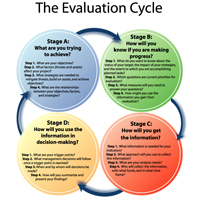EMI Evaluation Planning Process
The EMI evaluation planning process has four interconnected planning stages and several small steps within each planning stage.
What is the EMI Evaluation Cycle?
In Stage A, you get a clear picture of your project’s situation and define project success on multiple levels by answering:
- What are the ecological, social and economic goals and objectives of my project? What do we aim to achieve or change?
- What are the threats and assets affecting my project? What is preventing progress and what is moving us forward?
- What are the strategies and activities of the project? What are our on-the-ground approaches and how are we implementing them?
- How do our strategies minimize threats and/or capitalize on assets to move us closer to our goals and objectives? That is, what is the connected story behind what we are doing and aiming to achieve within a complex system?
- What organizational process issues, such as leadership or communication, affect our project’s progress?
In Stage B, you use the situation map you created in Stage A to lay out a framework for measuring progress on multiple levels by answering:
- What do we want to know? That is, what evaluation questions do we want to ask about the impact, implementation or approach of our project or about the situation in which we work?
- What do we need to know? What are our evaluation priorities?
- What indicators will we measure and what will we compare these measures against to answer our questions and assess progress?
- How might you use this information to affect decision-making or communicate with stakeholders?
In Stage C, you prepare for the logistics of undertaking your evaluation plan. This includes thinking about:
- Where will data come from? Is it already available or will we collect it, and if so, how?
- How will we need to process or analyze thedata to give us a clear answer to our evaluation question?
- Who will be responsible for these activities?
In Stage D, you consider ways to tie the evaluation back to decision-making by answering:
- What will be our trigger points? At what level, amount or rate of change of an indicator will we change course or reconsider our strategies?
- What possible actions might we take if a trigger point is reached?
For help on how to apply this process see Training, Facilitation, and Tools and Resources
|


